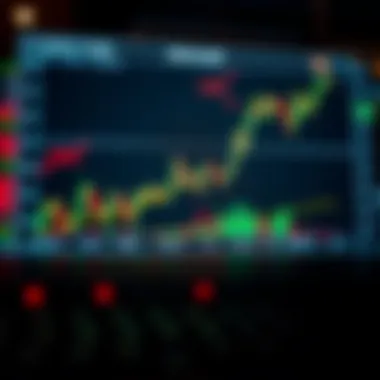Understanding Forex Market Opening Hours on Sundays


Intro
When Sunday rolls around, the Forex market transitions from a period of inactivity to the bustling environment traders are accustomed to throughout the week. Markets open at 5 PM EST on Sundays, signaling the start of a new trading week. This timing presents distinct advantages that savvy traders can exploit. It's not just about knowing when the market opens, but understanding how the activities during these early hours can affect price movements and trading strategies.
In this guide, we delve deep into the nuances of the Forex market's Sunday opening. We will discuss the impact of global time zones, practical trading strategies tailored for this specific timeframe, and essential terminologies that will enhance your comprehension of Forex operations. Ultimately, this resource aims to provide the necessary insights for both rookie and battle-hardened traders to make informed decisions and maximize potential outcomes.
Investment Dictionary
Key Terms and Definitions
To navigate the Forex market efficiently, one must grasp certain fundamental terms:
- Pip: The smallest price move that a given exchange rate can make based on market convention. In most pairs, this is typically the fourth decimal place.
- Spread: The difference between the buy and sell price of a currency pair; this can affect trading costs significantly.
- Leverage: A tool that allows traders to control larger positions with a smaller amount of capital.
- Lot: The volume or size of a trade. In Forex trading, it is usually categorized into standard lots, mini lots, and micro lots.
Common Investment Strategies
The Sunday opening offers a unique landscape for traders to consider various strategies, often including:
- Position Trading: Involves taking long-term positions based on fundamental analysis, which could be effective when entering a new week market.
- Scalping: A strategy aimed at making numerous small profits on minor price changes, particularly useful during the early hours of the opening when volatility may increase.
- Swing Trading: Traders spot opportunities for short-term gains based on shifts in market sentiment, especially after the weekend news cycle.
Expert Advice
Tailored Investment Strategies
Entering a Forex trade on a Sunday requires specific strategies distinct from midweek tactics. Consider setting stop-loss orders tight to manage potential volatility as positions are initiated. Assessing economic news released over the weekend can provide extra insights into market movements as the session starts.
Risk Assessment and Management
Every trading opportunity comes with risks. On Sunday, the lack of liquidity during the early opening hours can lead to unexpected price swings; hence, maintaining proper risk management is critical. It’s advisable to diversify trading positions and not to commit more than a small fraction of your capital to avoid larger losses during these unpredictable hours.
Understanding the dynamics of the Forex market on Sundays can be the difference maker for a trader’s success.
Preface to the Forex Market
The Forex market operates around the clock, making it the largest and most liquid financial market in the world. Understanding this market isn’t just an academic exercise; it’s crucial for anyone looking to navigate the complex waters of foreign exchange trading. The importance of diving into the mechanics of the Forex market lies not only in grasping how it works but also in recognizing the unique opportunities that different times of trading present.
When we look specifically at the Sunday opening of the Forex market, we see an intriguing aspect of trading that can reward informed traders while presenting potential risks for the unprepared. This knowledge is indispensable, particularly for individual investors and financial enthusiasts eager to maximize their returns. After all, being equipped with the right information can often mean the difference between a successful trade and a missed opportunity.
Definition and Functionality
Forex, short for foreign exchange, referes to the marketplace where currencies are traded. Unlike conventional stock markets, Forex operates without a centralized exchange; instead, it is distributed globally across various trading centers in different time zones.
The functionality of Forex hinges on the exchange of currency pairs. For instance, the Euro and the US Dollar can be traded against each other, represented as EUR/USD. Participants in this market include central banks, commercial banks, traders, corporations, and even individual retail investors, all seeking to profit from fluctuations in currency values.
Importance of Understanding Market Hours
Understanding market hours is paramount in Forex trading, especially when considering the Sunday opening. The time when Forex opens influences the volatility and liquidity of the market, which in turn can impact trading strategies.


- Market Liquidity: During the opening hours on Sunday, liquidity might vary significantly compared to regular trading days. Knowing when liquidity is at its peak can help traders execute their orders more efficiently without slippage.
- Volatility Factors: The Sunday market can experience increased volatility as traders react to news or events that occurred over the weekend. Understanding this can help traders strategize better.
- Global Influence: Events in one part of the world can affect other regions due to the interconnectedness of the global economy. Thus, being aware of global economic releases or changes during the weekend can position traders advantageously.
"Understanding when and how the market operates isn’t merely beneficial; it’s essential for anyone hoping to trade effectively."
Grasping these aspects underscores the complexity and opportunity found within the Forex market, particularly as the week kicks off on Sundays.
Global Forex Market Structure
The structure of the Forex market is akin to a sprawling web connecting traders across the globe, each thread influencing the other. Understanding this framework is essential for anyone looking to navigate the complexities of currency exchange. Not only does familiarity with the global market structure enhance trading strategies, but it also enables individuals to anticipate market movements effectively. As the Forex market operates 24 hours a day, recognizing its various segments can directly impact trading outcomes.
Decentralized Nature of Forex
Unlike stock exchanges, which are often centralized and regulated by specific authorities, the Forex market operates in a decentralized manner. This means that transactions occur through a network of global banks, brokers, and investors rather than in a singular physical location. This arrangement results in several noteworthy advantages:
- Accessibility: Traders from any part of the world can engage in Forex trading at any time, irrespective of their geographic location.
- Diverse Participants: The decentralized nature permits a broader array of participants, from central banks and financial institutions to individual retail traders.
- Reduced Influence of Individual Entities: The market's vastness ensures that no single entity can manipulate it to a significant degree, creating a more stable trading environment.
The decentralized format is crucial to the Forex market's flexibility, allowing traders to tap into liquidity and price movements seamlessly.
Major Trading Centers Worldwide
Forex trading is concentrated in several key financial centers, each contributing uniquely to market dynamics. The major trading centers include:
- London: Often referred to as the Forex capital of the world, London accounts for a substantial portion of global trading volume. The market opens here first on Sunday, setting the stage for the week ahead.
- New York: Following London, New York serves as a vital hub, especially when it comes to the overlap with the London session, further enhancing liquidity.
- Tokyo: The Asian market kicks off with Tokyo, offering unique opportunities driven by its distinct economic influences.
- Sydney: This center signals the beginning of the trading week, allowing events in the Asia-Pacific region to shape the Forex landscape.
Understanding the interactions between these centers is fundamental. For example, the overlapping hours between London and New York witness heightened trading activity, often leading to increased volatility and multiple opportunities for traders.
Overlapping Trading Sessions
One of the most intriguing features of the Forex market is the overlapping trading sessions. These are periods when two or more major trading centers are open simultaneously. The overlaps can significantly affect currency movements. Here’s a breakdown of some key overlaps:
- London/New York: The most significant overlap, as both the London and New York markets are active about six hours. This period often presents traders with heightened volatility and substantial volume.
- Tokyo/London: Occurring in the early morning, the overlap allows traders to react to news and events emerging from both markets, often leading to considerable price movements.
- Sydney/Tokyo: While less prominent, this overlap can still offer trading opportunities, particularly for currencies influenced by the Asia-Pacific economies.
The implications for traders are significant. Recognizing when these overlaps occur enables participants to schedule trades strategically, aligning their activities with periods of heightened market activity. Knowing when the market is likely to react can be a game-changer when shaping trading strategies.
Understanding the market structure expands your strategic options when trading currencies. Each trading center contributes to its rhythm, making timing crucial.
The global Forex market structure not only defines connectivity in trading but is also a vital consideration in capitalizing on market opportunities. As traders deepen their grasp of its decentralized form, major trading centers, and overlaps, they cultivate a more informed approach to trading strategy as the week unfolds.
Sunday Opening Times Explained
Understanding the opening times of the Forex market on Sundays is crucial for traders looking to optimize their strategies and make informed decisions. The ability to trade outside of traditional hours can give traders a leg up on potential opportunities and risks that might arise from the global economic landscape.
Sunday's opening signifies the start of a new trading week, a time when market sentiment can shift rapidly due to the unfolding of geopolitical events over the weekend. Therefore, grasping when and how the Forex market operates on Sundays allows traders to better position themselves for the week ahead.
When Does Forex Market Open on Sunday?
The Forex market officially opens at 5 PM EST on Sunday. This timing aligns with the closing of the weekend in many regions and marks the transition from the non-trading period to an active trading environment. Traders should note that this opening time can vary globally due to the effect of time zones.


It's essential for participants to adjust their trading strategies based on this schedule. While many may anticipate significant market movements right at the open, the reality can be a mixed bag of low volume and minimal volatility, especially during the initial hour after opening.
Time Zone Considerations
GMT
Greenwich Mean Time (GMT) is often viewed as the benchmark for time in the Forex market. At 10 PM GMT on Sunday, the Forex market opens. This time is especially relevant for traders based in Europe and Africa.
Being close to GMT means traders can react promptly to market news as it unfolds. The key characteristic of GMT is its neutrality, making it a universal reference point. However, its standard nature can also be seen as a disadvantage, as traders in other time zones may miss out on crucial trading opportunities. The benefit of using GMT is the alignment with various global markets, as financial news often breaks around this hour.
EST
Eastern Standard Time (EST) serves as another critical reference point for traders, particularly those based in North America. As mentioned, the Forex market opens at 5 PM EST. This alignment allows traders to start the week with a clear head after a restful weekend.
One of the standout features of EST is that it coincides perfectly with the closing of various North American markets, like stocks and commodities, providing an immediate reaction window for any developments or announcements over the weekend. This close timing can be quite beneficial, as traders can assess any shifts in sentiment caused by these markets. However, traders situated outside of EST will need to adapt, which could complicate their trading strategies.
Other Relevant Time Zones
Several other time zones also come into play, especially for traders in regions such as Asia and Australia. For instance, Tokyo is 14 hours ahead of EST. This means that when the Forex market opens on Sunday evening in the US, it’s already the afternoon on Monday in Japan.
In markets like Tokyo, traders often react to events that happened over the weekend. This can create unique dynamics, particularly for currencies like the Japanese yen. The challenge presented by different time zones is keeping a pulse on global events and how they may influence currency movements. Understanding how these zones intersect with market timing can help traders leverage their local knowledge for better outcomes.
Being aware of the Forex opening on Sunday isn’t just about the timing; it determines how one strategizes for the incoming week. Each trader may find opportunities and risks that differ based on their local times.
The different characteristics and implications of various time zones highlight the importance of solid time management in trading strategies. Successful participation in the Forex market requires proficiency in adapting to these time differences for maximal impact.
Impact of Sunday Opening on Trading Strategies
The Sunday opening of the Forex market plays a crucial role in shaping trading strategies, especially for those who are keen to remain ahead of the curve. For traders, understanding the dynamics at this particular juncture can unlock new avenues for profit and bolster risk management tactics. The quiet hours after the weekend provide a unique environment that differs significantly from the bustling activity during the weekdays.
When the Forex market opens on Sunday, it can often lead to heightened volatility and liquidity levels. Early trading offers an opportunity for participants to react to news or events that may have occurred over the weekend, shaping their strategies based on fresh information. Additionally, the movements seen in these early hours often set the tone for the week ahead, influencing not only currency pairs but overall market sentiment.
Volatility and Liquidity Levels
Traders should pay close attention to the volatility and liquidity levels experienced during the Sunday opening. Generally, trading volumes can be lower compared to peak during regular business hours, leading to increased volatility. As such, price swings can be more pronounced. It’s not uncommon to see significant movements in currency pairs in response to geopolitical events or economic indicators announced during the weekend.
- Key considerations for volatility and liquidity:
- Lower liquidity can result in wider spreads.
- Increased risk for slippage when entering or exiting positions.
- Price changes may be sharper due to fewer participants in the market.
The distinction between a calm Sunday evening and a bustling Monday morning can’t be overstated. Savvy traders recognize that strategizing around this volatility can yield distinct advantages—or significant pitfalls.
Opportunities for Traders
Sunday trading offers unique opportunities for traders willing to seize the moment. New traders, in particular, might find that the quieter early hours allow for better analysis without the pressure of rapid-fire market changes. A few opportunities that arise include:
- Hedging against upcoming volatility: Many traders use the Sunday opening to establish positions that they might adjust or release once the major news events unfold in the week.
- Positioning for trend identification: Observing market movements right out of the gate can provide valuable clues about trends that may establish early in the week. Understanding these trends can inform decisions leading up to mid-week trading.
- Low-risk entry points: With the cautious nature of traders on Sunday evenings, entering positions at seemingly lower prices could present solid risk-reward setups.


Traders who keep a keen eye on the weekend market have a greater chance of uncovering significant movements that can be leveraged throughout the week.
Risks Associated with Early Trading
However, trading on Sunday isn’t without its risks. With lower liquidity comes the potential for mistakes and heavier losses. Here’s where one should tread carefully:
- Market Sentiment: The prevailing mood derived from Sunday trading may not last long into the week, resulting in sudden reversals.
- Data Delays: Economic data that manifests during the weekend may not immediately reflect in currency pricing, leading to speculative traps.
- Potential for Over-Leveraging: New traders might enter positions with heightened excitement, resulting in increased exposure that they might not be ready to manage.
It’s key for every trader to be aware of the double-edged sword that the Sunday opening presents—while it offers unique prospects, it can just as easily lead to unexpected losses.
In summary, the Sunday opening can be a veritable goldmine or a treacherous pitfall depending on one’s approach and strategy. Awareness of the market dynamics at play is crucial for any trader looking to maximize gains while mitigating risks.
Technical Analysis During Sunday Openings
Engaging in technical analysis during the Sunday openings in the Forex market can be a game changer for traders. As the week kicks off, the dynamics of the market can vastly differ from those seen during the typical trading hours. Understanding these differences is crucial for enhancing trading strategies. The Sunday opening provides a unique window of opportunity shaped by several factors.
One of the paramount aspects of technical analysis on Sundays is the reduced liquidity and increased volatility that often characterize the early hours of trading. With fewer traders active at this time, sharp price movements can occur, sometimes catching even seasoned traders off guard. This environment presents both risks and rewards; traders must tread carefully and be prepared to adjust their strategies accordingly.
Here's a closer look at what traders should keep in mind:
- Market Sentiment: Sentiment can shift significantly over the weekend. News events, geopolitical developments, or economic announcements made while the Forex market is closed can lead to immediate reactions once trading resumes. Understanding current sentiment can guide traders on potential price movements.
- Weekly Open Levels: The opening price on Sunday can set the tone for the week ahead. Many traders use this information to identify potential support and resistance levels, which can be vital in developing trading strategies.
- Understanding Gaps: Price gaps, which may occur at Sunday’s opening, are critical indicators of market sentiment. Gaps can signal strong buying or selling pressure, providing clues on market direction. Addressing these gaps through comprehensive analysis can be instrumental in executing well-timed trades.
Overlooking technical analysis at this time might lead to missed opportunities. While it can be tempting to shy away from trading when the market is less active, honing in on these unique conditions allows traders to capitalize on potential fluctuations and align their strategies accordingly.
Analyzing Chart Patterns
When it comes to analyzing chart patterns during the Sunday openings, traders have a distinct advantage if they already understand common formations. The early hours can sometimes bring clarity to trends that may develop throughout the week. Traders should pay attention to a few key patterns:
- Continuation Patterns: Look for signs indicating that a trend is likely to continue. Patterns like flags or triangles that form at the start of the week can often provide valid predictive insight if viewed with the market context in mind.
- Reversal Patterns: Patterns, such as head and shoulders or double tops/bottoms, should be scrutinized closely. They signal potential shifts that can be instrumental to traders looking to enter or exit positions early in the week.
- Candlestick Patterns: Pay special attention to candlestick formations, including dojis or engulfing patterns, which may hint at market indecision or reversal signals right at the opening.
Indicators to Monitor
In the context of Sunday trading, specific indicators can enhance a trader's efficacy:
- Moving Averages: Short-term moving averages can help identify immediate trends forming right after the opening. The crossover of moving averages during this time can also signal potential entry or exit points.
- Relative Strength Index (RSI): This momentum oscillator can provide insight into whether a currency is overbought or oversold right at the start of the week. An RSI above 70 signals potential overbought conditions, while a reading below 30 suggests oversold scenarios.
- Bollinger Bands: These can visualize market volatility and price levels during Sunday openings, allowing traders to see if price action is nearing an upper or lower band, indicating potential reversal points.
By integrating these methods of analysis and indicators into their trading strategies, traders can cultivate a sharp edge when trading during the Forex weekend open. Overall, the dynamic environment of the Sunday opening adds significant dimensions to technical analysis, urging participants to remain alert and adaptable.
Finale on Sunday Forex Trading
In the fast-paced world of Forex trading, understanding the Sunday opening is crucial for traders at all levels. This period marks the beginning of a new trading week, and recognizing how to navigate it can significantly influence trading outcomes. The Forex market does not rest, and given its unique structure, the Sunday opening presents both opportunities and challenges. Traders need to strategically consider their actions during this time, as it can set the tone for the days ahead.
Summary of Key Points
- Timing is Essential: The Forex market typically opens at 5 PM EST on Sundays, allowing traders to jump into action before many major markets open, setting the stage for the week.
- Volatility and Liquidity: Although liquidity is often lower during Sunday trading, it can come with unexpected volatility. Traders must be aware of potential price swings, as market movements may not align with conventional trends seen during the week.
- Global Collaboration: Understanding global time zones is essential. While the market officially opens in New York, the influence of other trading centers around the world plays an integral role in price movements, impacting how traders strategize their entries and exits.
- Risk Management: Trades initiated on Sunday can bring heightened risk due to the unpredictability of initial market reactions. Therefore, effective risk management strategies should be in place to safeguard one's investments.
"The Forex market is a world in itself, where timing and awareness of the global scene dictate survival and profit."
Final Thoughts on Trading Strategy
The Sunday opening offers a unique arena for traders, especially those quick on their feet. It’s not just about jumping into trades; it's about understanding the context in which those trades are made. As a trader, consider your long-term goals: Is your strategy designed for immediate gains, or aimed at sustaining in the longer haul?
- Evaluate market conditions: Prior to engaging on Sundays, conducting thorough analysis and employing various indicators can give a leg-up on potential movement.
- Stay Informed: Utilizing resources such as Bloomberg or Forex Factory can keep you abreast of news that may influence Sunday market dynamics.
- Be on the lookout for trends: Monitoring early price patterns can provide vital intelligence for the week ahead.
In summary, trading on Sundays is not for the faint-hearted but can yield favorable results if approached with prudent strategy and adequate knowledge. Understanding the nuances of Sunday Forex trading can pave the way for achieving greater success in the ever-evolving landscape of foreign exchange markets.



